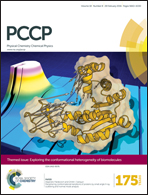Dissipative particle dynamics simulation study of poly(2-oxazoline)-based multicompartment micelle nanoreactor
Abstract
We investigate multicompartment micelles consisting of poly(2-oxazoline)-based triblock copolymers for nanoreactor applications, using the DPD simulation method to characterize the internal structure of the micelles and the distribution of reactant. The DPD simulation parameters are determined from the Flory–Huggins interaction parameter (χFH). From the snapshots of the micellar structures and radial distribution function of polymer blocks, it is clearly presented that the micelle is multicompartmental. In addition, by implementing the DPD simulations in the presence of reactants, it is found that Reac-C4 and Reac-OPh are associate well with the hydrophilic shell of the micelle, whereas the other two reactants, Reac-Ph and Reac-Cl, are not incorporated into the micelle. From our DPD simulations, we confirm that the miscibility (solubility) of reactant with the micelle has a strong correlation with the rate of hydrolysis kinetic resolution. Utilizing accurate methods evaluating accurate χFH parameters for molecular interactions in micelle system, this DPD simulation can have a great potential to predict the structures of micelles consisting of designed multiblock copolymers for useful reactions.


 Please wait while we load your content...
Please wait while we load your content...